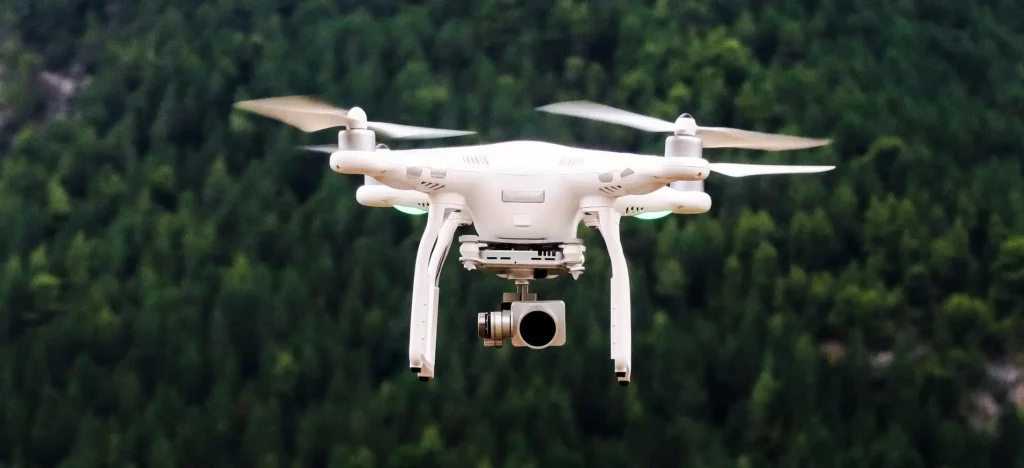The latest standard of Inspections embraces drones that master the art of data collection efficiently. UAV technology has encouraged industries in diverse practices. However, with all the advantages come a few downfalls. Though Drones aim for perfection, they have not been crafted flawlessly. Examine the subsequent 10 major Pros and Cons of UAV drones and discover more about everything drones have to offer!

ADVANTAGES:
- MAINTAINING SAFE ENVIRONMENT – UAVs are utilized in numerous occurrences due to their advancement in safety. With their remote control abilities, Drones monitor locations, communicate possible hazards, and notify threatening conditions.such as oil and gas refineries,pipelines and flare stacks. Not only this, Drone Technology is employed in the military during high-risk periods as well. Their features allow them to obtain real-time data to create and preserve a safe environment.
- COST SAVING TECHNOLOGY – As drone’s applicability becomes more extensive, their prices also drive towards being more pocket-friendly. People now acquire Drones not just for their industrial practices but also to fulfill their tech-savvy gadget’s passion. UAVs are no longer equipped only for the military, law authorities, or the elite. Since UAVs take over several workforces, vehicles, and operation activities in commercial uses, many costs are preserved. For example, a Drone is more economical to buy, sustain, and fuel than airplanes for inspections. In addition you don’t need to hire a ladder, aerial lifts, and other heavy equipment.
- QUALITY OF AERIAL IMAGING –

AERIAL PHOTOGRAPHY With their high-resolution cameras furnished with top-notch sensors, UAVs can take excellent Aerial Photographs, aerial videos and accumulate large volumes of accurate data. The data obtained is transformed into detailed 3D Maps and 3D Models for a complete analysis. 3D Mapping is particularly relevant to disclose cracks, damages, or other hazardous elements in disaster areas. Drones, when paired along with high-resolution images or 4K video abilities, is well-known for live streaming significant events such as entertainment, personal, political, and global affairs.
- PRECISION – UAVs appropriate GPS (the Global Positioning System) in their software, which is why they can be programmed and guided precisely to specific locations. For example, in Precision Agriculture, a Drone Aircraft is employed to perform many farming obligations like pesticide spraying, identification of weeds, monitoring crop health, crop damage, crop assessment, field soil analysis, Irrigation Monitoring etc. This feature of precision through the GPS conserves time and expenses for farmers.
- EASY CONTROLLABLE OR DEPLOYABLE – The regular advancement in drone-control technology allows operators to quickly deploy and operate drones even with a relatively minimal technical background. With an extensive range of low-cost drones available for several purposes, drones are open to a broad spectrum of operators. Unmanned aerial vehicles (UAVs) have a more comprehensive range of movement, fly lower in all directions, and can navigate effortlessly when contrasted to a crewed aircraft.
- SECURITY – Another advantage that weighs out the pros and cons of a drone is the security centered around them. With relevant permissions and licenses, drone operators can utilize an Unmanned Aircraft System (UAS) to render safety and surveillance to private organizations, potential venues, and other expenses. Drones can also accumulate reliable information from natural catastrophes to support safety and recovery efforts.
- MINIMIZES OBVIOUS DANGER AND HEALTH RISKS – With the support of a Drone, numerous dangers like elevation, wind, weather, and radiation that were earlier suffered by crew members have been replaced with more viable and safer alternatives. Drones facilitate straightforward and secure inspections of towering and complicated constructions like oil and gas refineries, flare stacks, and pipelines.
- IN-DEPTH AND DETAIL DATA INPLACE – Many drone models are launched into the market with obstacle avoidance capacities. They can operate quite close to constructions, and this encourages them to seize precise data. They capture high-resolution images or 4K videos that explicitly reveal cracks, damages, displaced wires, and additional defects that we cannot detect through our naked eye. UAVs allow obtaining complete data without endangering inspection crew members of the company.
- FLEXIBILITY FOR QUICK INSPECTIONS – Since Drones come with varied specifications, several can provide high or low altitude Inspections. The versatility of these characteristics empowers clients to customize the tools with ease for their projects. Drones are suitable for both regular and emergency scenarios, the Construction Industry abides by these advantages, especially building developers for Rooftop Inspections. Drones can carry out multiple roles, such as capturing high-quality photos, videos, thermal images, etc. This data is then transmitted and processed immediately, as opposed to the time-consuming conventional method.
- REACH HAZARDOUS AREA – UAVs make obtaining efficient data from hard-to-reach locations a cakewalk for industry professionals. It is the most suitable alternative to overcome limitations of traditional methods regarding worker’s safety, especially in hazardous situations like radiation monitoring, inspecting high-voltage lines. Drones also allow a more cost-effective approach toward inspections of these locations.
You may also like
DISADVANTAGES:
- PRIVACY – While drone’s benefits are endless, drone technology has several downsides to it. UAVs can quickly fall prey to manipulation and trespass a group or individual’s privacy. Though many desire to utilize drones for retaining safety, it could violate numerous individual liberties in the name of public security.
- LEGISLATIVE UNCERTAINTY – The use of Unmanned Aircraft Systems (UAS) has become widespread; however, the law is still developing, considering it is a novel technology in the industry. Specific practices installed for tiny drones also apply to commercial and recreational applications but are still vague in several dimensions. Rules for the regulation of drone movement and property protection from aerial trespassing are still in the making; thus, UAV technology functions in a judicial gray zone. There are numerous frictions between governmental regulations and any state or city laws to manage airspace property rights, because of which drone operators may violate rules they didn’t know about.
- SAFETY – Safety is a fundamental element to prioritize when operating drone technology. UAVs outfitted with high-quality sensors recognize possible collisions and safely engineer their way around them, making them a significant trait. These drone capacities must resemble those of the manned aircraft navigators. It is commendable to hire professional drone service providers who can operate an aerial drone without crashing it. Drones operated in heavily-populated regions have an amplified risk of ground impact or damage, mainly due to system malfunction or hacking.
- SOFTWARE ISSUES OR MALFUNCTION – There have previously been many drones that have fired weapons to commoners, generating a significant amount of casualties, injuries, and damages due to malfunctions or software blunders. Drone mishaps strike other military personnel’s safety as well. Drones are still in the process of improvement to limit accidents or hazards that can affect the health and safety of human lives.
- VULNERABLE TO WILD ANIMALS – Drones are susceptible to wild animal attacks and are sometimes also dangerous to nature. It is possible that when a drone operator is flying in a domain with a considerable number of wild animals, they crash against a tree or possibly conflict with a vulnerable animal. Large flying birds like eagles are regularly attacking and even capturing drones operating in their space to obtain crucial data.
- SPYING –

Many offenders employ drones as a strategy to target their victims and to maintain a track on them. The blatant propeller noises are no longer a concern and are unnoticeable, enabling criminals to invade someone’s privacy. Many drones furnished with thermal and night sensors identify life signs and efficiently target those currently of interest by the spy. Since UAVs can seize accurate data, they can register regular habits and recognize suspicious activities without permission.
- EASY TO HACK – One substantial downside to drone technology’s growth is its vulnerability. Hackers can quickly attack a drone’s central control system and become the drone’s original controller. The primary control system includes significant knowledge crucial for hackers to evade without the initial operator’s awareness. Hackers can acquire private information, corrupt or damage the files, and leak data to unauthorized third parties.
- WEATHER DEPENDENT – Drones are more vulnerable to weather conditions when contrasted to traditional aircraft. For example, if the climatic conditions are unfavorable, the UAV will not maneuver appropriately or gather reliable data or imagery. However, there are drones available that are more stable and can withstand gusts of wind successfully.
- KNOWLEDGE AND SKILL – As discussed earlier, if one necessitates seizing accurate, high-quality data, they need to possess the demanded skillset. This specification would indicate that an average farmer would require comprehensive training or a third party drone service provider to capture, process, and analyze farming data. With expanding operators in the industry, drone costs and its accompanying resource expenses will gradually reduce.
- DATA TRANSFER SPEED IS SLOW – One of the cons in expanding drone technology in precision agriculture is its data transmission speed, which some suppose could be a week. If the time necessitated for data delivery results in a farmers’ unproductivity and damage to fertilizers, crops, or pesticides, the operation of the drone would be a waste in the end. Thus, if data transfer speed is slow, suffering and damage can occur in that period, following all efforts going to waste.

